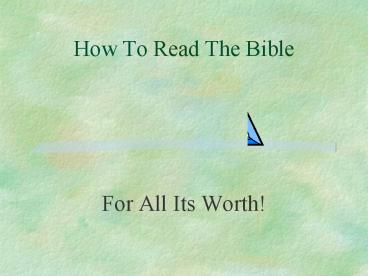How To Read The Bible - PowerPoint PPT Presentation
1 / 22
Title:
How To Read The Bible
Description:
Moses commanded books of law be put in the ark of the covenant (Deut 31:9,26) ... Ephesians, Colossians, Timothy, Philemon, Peter, Johns, Jude, Revelation ... – PowerPoint PPT presentation
Number of Views:87
Avg rating:3.0/5.0
Title: How To Read The Bible
1
How To Read The Bible
- For All Its Worth!
2
Goals For This Class
- To give a basic approach to understanding the
biblical text - To examine historical methods of interpretation
- To consider other methods of interpretation
- To promote unity of shared understanding
- To relate elders views on interpretation
3
Not Goals For This Class
- To ensure everybody believes what I do
- To ensure everybody believes the same thing
- To debate controversial passages of scripture
- To negate or endorse any particular
interpretative approach - To confuse, frustrate, or agitate truthseekers
4
The Canon
5
Definition of canon
- a straight rod
- a carpenters rule
- The Canon of Truth - 367 AD
6
Canonical Books
- Authentic
- Genuine
- Of divine authority
- Inspired by God
7
Uncanonical Books
- The Apocrypha
- The Shepherd of Hermas
- The Epistle of Barnabas
8
Why Was A Canon Necessary?
- Death of apostles and prophets
- Other writings purported to be inspired
- Edict of Diocletian in 302 AD
9
Origin Of The Bible
10
Bible Origins
- Bible comes from the Greek word biblia
- biblia means books
- Old Testament books were written over a time
period of about 1100 years - Originally teaching was passed down verbally by
oral tradition - Ultimately written on clay, parchment, papyrus or
vellum by scribes
11
Old Testament
- Written between 1400 - 400 BC
- Moses commanded books of law be put in the ark of
the covenant (Deut 319,26) - Later placed in temple with books from Joshua
through David and Solomon added - 50 years after the temple was rebuilt, Ezra
collected sacred writings and added the major
and minor prophets - Compiled by Ezra and Nehemiah in 400 BC
12
Septuagint
- Greek Translation
- completed by 130 AD
- included all 39 books
- probably used by Jesus and disciples
- Old Testament canon fixed in 100 AD at Jamnia
13
New Testament Beginnings
- Early Christians used the Jewish scriptures
- Christian Oral Tradition from 30-100 AD
- Paul and others wrote letters to early churches
to deal with problems and issues - Later two apostles and two close acquaintances of
Jesus wrote personal testimonies - John wrote his Revelation from Patmos
- written between 50-100 AD
- written in Greek
14
New Inspired Books
- Paul claimed his teaching inspired of God (I Cor
27-13) - John did also for his Revelation (Rev 12)
- Paul intended his epistles to be read aloud (Col
416) - Paul wrote these things might remain after his
departure (II Pet 115 31-2) - Paul quoted as Scripture Matt 1010, Luke 107 (I
Tim 518) - Peter calls Pauls epistles other scripture (II
Peter 315-16)
15
Appearance Of First N.T. Books
- Palestine
- Matthew, James, Hebrews
- Asia Minor
- John, Galatians, Ephesians, Colossians, Timothy,
Philemon, Peter, Johns, Jude, Revelation - Greece
- Corinthians, Philippians, Thessalonians, Luke?
- Crete
- Titus
- Rome
- Mark, Acts, Romans
16
Early Writers Quote N.T. Books
- Ignatius AD 110
- Papias AD 70-155
- The Didache AD 80-120
- Barnabas AD 90-120
- Hermas AD 100-140
- Tatian AD 160
- Justin Martyr AD 140
17
Constantine
- I have thought it expedient to instruct your
Prudence to order 50 copies of the Sacred
Scriptures, the provision and use of which you
know to be the most needful for the instruction
of the church, to be written on prepared
parchment, in a legible manner, and in a
commodious and portable form, by transcribers
thoroughly practised in their art.
18
Homologoumena Antilegomena
- 20 books acknowledged as genuine
- Gospels, Acts, Pauls epistles, I John, I Peter
- 7 books scrutinized for stylistic differences and
added in the 4th century - Hebrews, II-III John, II Peter, Jude, James,
Revelation
19
The Apocryphal Books
- I-II Esdras Baruch
- Tobit Song of the 3 Children
- Judith Story of Susannah
- Esther Bel and the Dragon
- Wisdom Prayer of Manasses
- Ecclesiasticus I-II Macabees
20
New Testament Canon
- 27 New Testament books generally agreed upon by
100 AD - Council of Carthage held in 387 AD
- Bishop Athanasius of Alexandria pens letter
naming the 27 books
21
Questions or Comments?
22
Next WeekHermeneutics Part II































